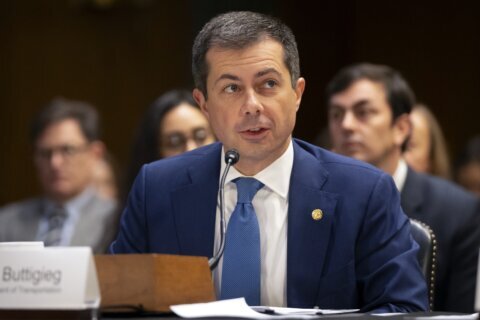NEW YORK (AP) — The 12-month grace period for student loan borrowers ended on Sept. 30. The “on-ramp” period helped borrowers who are struggling to make payments avoid the risk of defaulting and hurting their credit score.
“The end of the on-ramp period means the beginning of the potentially harsh consequences for student loan borrowers who are not able to make payments,” said Persis Yu, Deputy Executive Director at the Student Borrower Protection Center.
Around 43 million Americans have student loan debt, amounting to $1.5 trillion. Around eight million of those borrowers had enrolled in the SAVE plan, the newest income-driven repayment plan that extended the eligibility for borrowers to have affordable monthly student loan payments. However, this plan is currently on hold due to legal challenges.
With the on-ramp period and a separate program known as Fresh Start ending and the SAVE plan on hold, student loan borrowers who are struggling to afford their monthly payments have fewer options, added Yu. Student loan borrowers who haven’t been able to afford their monthly payments must consider their options to avoid going into default.
If you have student loans, here’s what you need to know.
What was the on-ramp period?
The Education Department implemented this grace period to ease the borrower’s transition to make payments after a three-year payment pause during the COVID-19 pandemic. During this year-long period, borrowers were encouraged to keep making payments since interest continued to accumulate.
“Normally, loans will default if you fall about nine months behind on making payments, but during this on-ramp period, missed payments would not move people towards defaulting and then being subject to forced collections. However, if you missed payments, you still be falling behind ultimately on repaying your loans,” said Abby Shaforth, director of National Consumer Law Center’s Student Loan Borrower Assistance Project.
Since this grace period has ended, student loan borrowers who don’t make payments will go delinquent or, if their loans are not paid for nine months, go into default.
Borrowers who cannot afford to make payments can apply for deferment or forbearance, which pause payments, though interest continues to accrue.
What happens if I don’t make my payments?
Borrowers who can’t or don’t pay risk delinquency and eventually default. That can badly hurt your credit rating and make you ineligible for additional aid and government benefits.
If a borrower missed one month’s payment, they will start receiving email notifications, said Shaforth. Once the loan hasn’t been paid for three months, loan servicers notify to the credit reporting agencies that the loan is delinquent, affecting your credit history. Once the borrower hasn’t paid the loan for nine months, the loan goes into default.
If you’re struggling to pay, advisers first encourage you to check if you qualify for an income-driven repayment plan, which determines your payments by looking at your expenses. You can see whether you qualify by visiting the Federal Student Aid website. If you’ve worked for a government agency or a non-profit organization, you could also be eligible for the Public Service Loan Forgiveness Program, which forgives student debt after 10 years.
What happens when a loan goes into default?
When you fall behind on a loan by 270 days — roughly 9 months — the loan appears on your credit report as being in default.
Once a loan is in default, it goes into collections. This means the government can garnish wages (without a court order) to go towards paying back the loan, intercept tax refunds, and seize portions of Social Security checks and other benefit payments.
What if I can’t pay?
If your budget doesn’t allow you to resume payments, it’s important to know how to navigate the possibility of default and delinquency on a student loan. Both can hurt your credit rating, which would make you ineligible for additional aid.
If you’re in a short-term financial bind, you may qualify for deferment or forbearance — allowing you to temporarily suspend payment.
To determine whether deferment or forbearance are good options for you, you can contact your loan servicer. One thing to note: interest still accrues during deferment or forbearance. Both can also impact potential loan forgiveness options. Depending on the conditions of your deferment or forbearance, it may make sense to continue paying the interest during the payment suspension.
What is an income-driven repayment plan?
The U.S. Education Department offers several plans for repaying federal student loans. Under the standard plan, borrowers are charged a fixed monthly amount that ensures all their debt will be repaid after 10 years. But if borrowers have difficulty paying that amount, they can enroll in one of several plans that offer lower monthly payments based on income and family size. Those are known as income-driven repayment plans.
Income-driven options have been offered for years and generally cap monthly payments at 10% of a borrower’s discretionary income. If a borrower’s earnings are low enough, their bill is reduced to $0. And after 20 or 25 years, any remaining debt gets erased.
What is the latest with the SAVE program?
In August, the Supreme Court kept on hold the SAVE plan, the income-driven repayment plan that would have lowered payments for millions of borrowers, while lawsuits make their way through lower courts.
Eight million borrowers who had already enrolled in the SAVE plan don’t have to pay their monthly student loan bills until the court case is resolved. Debt that already had been forgiven under the plan was unaffected.
The next court hearing about this case will be held on Oct. 15.
What happened with the Fresh Start program?
The Fresh Start program, which gave benefits to borrowers who were delinquent prior to the pandemic payment pause, also closed on Sept. 30. During this limited program, student loan borrowers who were in default prior to the pandemic were given the opportunity to remove their loans from default, allowing them to enroll in income-driven payment plans, or apply for deferment, among other benefits.
——
“The Associated Press receives support from Charles Schwab Foundation for educational and explanatory reporting to improve financial literacy. The independent foundation is separate from Charles Schwab and Co. Inc. The AP is solely responsible for its journalism.”
Copyright © 2024 The Associated Press. All rights reserved. This material may not be published, broadcast, written or redistributed.







